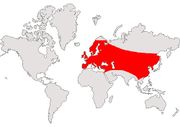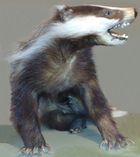European Badger
| European Badger | |
|---|---|
 |
|
| Conservation status | |
| Scientific classification | |
| Kingdom: | Animalia |
| Phylum: | Chordata |
| Class: | Mammalia |
| Order: | Carnivora |
| Family: | Mustelidae |
| Genus: | Meles |
| Species: | M. meles |
| Binomial name | |
| Meles meles Linnaeus, 1758 |
|
 |
|
| Range map | |
The European Badger (Meles meles) is a mammal indigenous to most of Europe (excluding northern Scandinavia, Iceland, Corsica, Sardinia, Sicily and Cyprus) and to parts of Asia. It is a member of the Mustelidae family, and is very closely related to the stoats, otters, weasels, minks and other badgers. Accepted subspecies include Meles meles meles (Western Europe), Meles meles marianensis (Spain and Portugal), and Meles meles leptorynchus (Russia). Some authors regard two other badgers as additional subspecies: Meles meles leucurus (the Asian Badger: China and Tibet), and Meles meles anakuma (the Japanese Badger). If these are included the name Eurasian badger is more appropriate and the distribution covers Asia from about 15° to 65° North, and from about 10° West to 135° East.
Contents |
Description
The general hue of its fur is grey above and black on the under parts with a distinctive black and white striped face and white-tipped ears. European badgers are around 70 cm long with a tail of about 20 cm and weigh 10 kg on average, but weights can vary enormously. Badgers do not hibernate, although in areas with cold winter climates they may become torpid for two or so days at a time[2][3] having put on fat in the autumn to help them get through the winter months. In parts of Russia, badgers have been reported to weigh up to 42 kg (92.5 lb) in the autumn.
Diet
Though classified as belonging to the order Carnivora, badgers are effectively omnivorous and insectivorous[4]; most of their diet consists of earthworms, although they also eat insects, spiders, scorpions, small mammals, eggs, young birds, reptiles, berries, roots, bulbs, nuts, and fruit. Badgers also dig up the nests of wasps and bumblebees in order to eat the larvae. Badgers will eat carrion, particularly in locations where there are predators that prey on larger animals, making it possible for the badgers to scavenge kills.
Badgers prefer grazed pasture and woodland, which have high numbers of earthworms exposed, and dislike clay soil, which is difficult to dig even with their powerful claws. In urban areas, some badgers scavenge food from bins and gardens.
Behaviour
Badgers are nocturnal and spend the day in their setts, or extensive networks of tunnels dug in well-drained ground (or sometimes beneath buildings or roads). Setts give shelter from the weather and predators, which are humans, wolves and leopards. Badgers are territorial, but can be found in groups often called clans. Group size varies between 2 and 12. Each clan has a dominant male and female which are often (but not always) the only members of the clan to reproduce. Female badgers can display delayed implantation: after mating at any time of the year, they keep the fertilised eggs in suspended development until an appropriate time, at which stage the eggs are implanted and begin developing. Badgers have a gestation period of 7–8 weeks and give birth to 1-5 offspring. Males are called boars and females sows; the young are cubs. Badgers live for up to 15 years (average 3 years) in the wild, and up to 19 years in captivity. If they survive their first year, the most common cause of death is by road traffic. Badgers are susceptible to Baylisascaris infestations. They can catch and carry rabies[5] and are believed to transmit bovine tuberculosis (see below).
Badgers, hunting and blood sports

Badger baiting, in which a badger is attacked by a succession of dogs, often accompanied by heavy gambling, has been practised since at least the Middle Ages in Europe. When the badger is no longer able to fight, it is killed. Badger digging is the process of sending dogs down the tunnels of a badger sett in order to locate the badger, after which the diggers try to dig down to the badger. Dachshunds (literally "Dachs-Hunde", "badger dogs") were originally bred for this purpose.
In the UK, the Badger Trust believes that lamping (night-time hunting on foot with strong lamps) for badgers, badger baiting and badger digging persist despite all being illegal. Badger baiting was outlawed in 1835; badger digging in 1973. Lamping with dogs is legal only if rabbits are hunted since the passing of the Hunting Act 2004, lamping with guns is legal only for species not protected under the Wildlife and Countryside Act 1981. Under the Protection of Badgers Act of 1992 it is an offence to kill a badger or to interfere with a sett without a licence from Natural England.
The results of the first national badger survey published in 1990 estimated that 9,000 badgers were killed each year by badger digging.
Badgers and the spread of bovine TB
British farmers and successive governments have long believed that bovine TB was being spread by badgers and infecting the national dairy herd, and since the 1970s badgers have been culled by gassing (now ceased) and shooting in attempts to prevent this spread.
Tests carried out by the Ministry of Agriculture in the early 1970s showed that TB was more common in badgers than in other species. In the first Badger Act (1973), meant that licenses had to be issued for the killing of badgers. However, there are various other theories concerning the transmission of TB to cattle, and badger culling remains a contentious issue in the UK. Research into the specific mechanisms of how cattle contract bovine TB from badgers and into normal levels of transmission when culling is not practised is scanty. Following the recommendations of the Krebs report of 1997 (Bovine Tuberculosis in Cattle and Badgers),[6] a research trial of badger culling, the Randomised Badger Culling Trial(RBCT),[7] was begun. Part of the aim was to establish baselines which could be used to assess the efficacy of culls in future. As noted in the Godfray report (Independent Scientific Review of the Randomised Badger Culling Trial and Associated Epidemiological Research) of March 2004, the trial has experienced major problems, in particular delays in culling due to restrictions imposed by the control of the foot and mouth disease epidemic in 2001.
The Randomised Badger Culling Trial [7] (designed, overseen and analysed by the Independent Scientific Group on Cattle TB, or ISG[8]) was a large field trial of widescale (proactive) culling and localised reactive culling (in comparison with areas which received no badger culling). In their final report[9] the ISG concluded: "First, while badgers are clearly a source of cattle TB, careful evaluation of our own and others’ data indicates that badger culling can make no meaningful contribution to cattle TB control in Britain. Indeed, some policies under consideration are likely to make matters worse rather than better. Second, weaknesses in cattle testing regimes mean that cattle themselves contribute significantly to the persistence and spread of disease in all areas where TB occurs, and in some parts of Britain are likely to be the main source of infection. Scientific findings indicate that the rising incidence of disease can be reversed, and geographical spread contained, by the rigid application of cattle-based control measures alone." On 26 July 2007, the Minister of State, Department for Environment, Food and Rural Affairs (Lord Rooker) said "My Lords, we welcome the Independent Scientific Group’s final report, which further improves the evidence base. We are carefully considering the issues that the report raises, and will continue to work with industry, government advisers and scientific experts in reaching policy decisions on these issues".[10]
Badgers are popular with the general public, if not with farmers, and societies exist to protect the species. The Badger Trust is the umbrella body for a series of groups like the Lancashire Badger Group formed for the conservation of these animals. Their most serious threat is automobile traffic, which kills about 50,000 badgers a year in Britain.[11] In 2004, there were between 250,000 and 300,000 badgers in the wild in Britain.[12][13]
Gallery
 Foraging |
 Eurasian Badger foraging for food. |
 Eurasian Badger eating. |
 Eurasian Badger examining potential food. |
 Eurasian Badger eating mashed potato. |
 Sett (den) |
 Droppings |
 Tracks |
 Tracks on mud |
 Tracks on snow |
References
- ↑ Kranz, A., Tikhonov, A., Conroy, J., Cavallini, P., Herrero, J., Stubbe, M., Maran, T., Fernades, M., Abramov, A. & Wozencraft, C. (2008). Meles meles. In: IUCN 2008. IUCN Red List of Threatened Species. Downloaded on 21 March 2009. Database entry includes a brief justification of why this species is of least concern
- ↑ "J Goszczyski1; S Juszko1; A Pacia1; J Skoczyska1 "Activity of badgers (''Meles meles'') in Central Poland", ''Mammalian Biology'', '''70''', 1, 1 January 2005 , pp. 1-11(11)". Ingentaconnect.com. 2005-01-01. doi:10.1078/1616-5047-00171. http://www.ingentaconnect.com/content/urban/161/2005/00000070/00000001/art00001. Retrieved 2010-03-15.
- ↑ Haines, Laura, "Chapter 4: Hibernation and Torpor" in Book 2: Environmental Physiology, p 126. Open University Animal Physiology course materials. (Large file: 9.45 MB)
- ↑ http://weebls-stuff.com/songs/badgers/
- ↑ who-rabies-bulletin.org
- ↑ defra.gov.uk
- ↑ 7.0 7.1 defra.gov.uk
- ↑ defra.gov.uk
- ↑ defra.gov.uk
- ↑ Department of the Official Report (Hansard), House of Lords, Westminster (2007-07-26). "publications.parliament.uk". publications.parliament.uk. http://www.publications.parliament.uk/pa/ld200607/ldhansrd/text/70726-0001.htm#st_11. Retrieved 2010-03-15.
- ↑ Harris, S., Cresswell, W., Reason, P. & Cresswell, P. (1992) An integrated approach to monitoring Badger (Meles meles) population changes in Britain. in: Wildlife 2001: Populations (ed. D. R. McCullough and R. H. Barrett), pp. 945-953. Elsevier Applied Science, London.
- ↑ Harris, S., Morris, P., Wray, S. & Yalden, D. (1995) A Review of British Mammals: Population estimates and conservation status of British mammals other than Cetaceans. Joint Nature Conservation Committee, Peterborough.
- ↑ Wilson, G., Harris, S. & McLaren, G. (1997) Changes in the British Badger Population 1988-1997. People's Trust for Endangered Species, London.
- Ernest Neal & Chris Cheeseman Badgers (Poyser, 2002)
- General
- ARKive Photographs and video
- The Badger Trust - representing over 80 British badger groups
- Steve Jackson's Badger Pages - Facts about and photos of the badgers of the world
- Badgerland - The Definitive On-Line Guide to Badgers (Meles meles) in the UK
- Badgerwatcher.com - A guide to watching badgers in the UK
- Wildlifeonline - Natural History of the European Badger
- Lancashire Badger Group.
- Science & Nature: Animals, BBC.
- Badgers in the Netherlands, Badgergroup Brabant Foundation.
- Badger Survey in the Netherlands 2000-2001, The Census Foundation.
- Waarneming.nl Originally a Dutch site, but you can change language at the top of the page. Sightings, pictures and distribution maps of European badgers in the Netherlands.
- Badgers in France, L’assiociation Meles.
- Badgers and TB in the UK
- DEFRA (UK government department) position on badgers and TB
- Executive summary of the Krebs Report Bovine Tuberculosis in Cattle and Badgers 1997
- The Randomised Badger Culling Trial
- Godfray Report, Independent Scientific Review of the Randomised Badger Culling Trial and Associated Epidemiological Research, March 2004. PDF format
- National Farmers Union proposals to control badgers (would involve repeal of the 1992 act) July 2005
- NFBG (now Badger Trust) response to the National Farmers Union proposals, August 2005
- Claims of continued badger-hunting in the UK
- Allegations of lamping (among other practices) were made in the appendix to the NFBG (now Badger Trust) response to the Krebs Report
|
|||||||||||||||||||||||||||||||||||||||||||||||||||||||||||||||||||||||||||||||||||||||||||||||||||||||||||||||||||||||||||||||||||||||||||||||||||||||||||||||||||||||||||||||||||||||||||||||||||||||||||||||||||||||||||||||||||||||||||||||||||||||||||||||||||||||||||||||||||||||||||||||||||||||||||||||||||||||||||||||||||||||||||||||||||||||||||||||||||||||||||||||||||||||||||||||||||||||||||||||||||||||||||||||||||||||||||||||||||||||||||||||||||||||||||||||||||||||||||||||||||||||||||